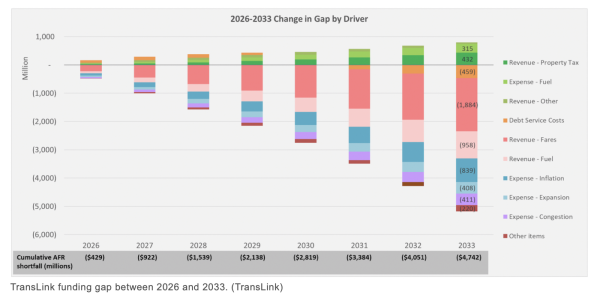
Ok, so we Lower Mainlanders are well positioned to land world capital in the form of new addresses that will continue to pay their property taxes (whether folks live in the units or not) for decades to come. An expanded tax base is the gift that keeps on giving. Good for us, maybe.
The so-called best practice of TOD (Transit Oriented Development) continues to be referenced as justification for higher densities near transit services. BTW (by the way) TOD is the same as TOA (Transit Oriented Areas) which is more recent professional planning lingo (read justification) for dropping towers near stations and exchanges adjacent to established neighbourhoods.
What happens when TOD aspirations collide with service reductions given the recently announced transit budget shortfall ($4.7 billion by 2033)? Shouldn’t such budgetary drama, at a time when we justify blockbusting as “best practice rationale”, also mean NSNT “No Service No Towers”?
Should tower heights be cut in half if transit service is reduced by 50%?
We are heading down a dangerous road (transit arterial) when we pre-justify and don’t deliver the services, especially when daily lives become even less affordable because transit costs will increase thereby impacting the ability to pay for NECTBAH “not even close to being affordable housing”. The province, with its housing mandate that overrides municipal zoning, can’t have it both ways. The same goes for the costs of infrastructure upgrades and expansion.
Remember, more density is supposed to mean stabilized/lower taxes by expanding the base unless your neighbourhood zoning policy creates more lucrative “highest and best use” potential. You will be forced to sell out and relocate (assuming you can find housing elsewhere) when you can no longer afford to pay property taxes that reflect the government’s speculative behavior embodied in each successive planning policy overlay.
Let’s (playfully) extrapolate where this is all going by inventing some new “best practice terms” that help pay for the daily services we all currently cherish. By overly relying on the “magic of exploiting density”, local governments might start to excuse themselves from providing the necessary services that have somehow been delivered for decades (thank you Vancouver Parks Board for showing us how to do this before your operational budgets were taken over by previous councils).
Here are some future, intentionally exploitive, “Best Practices”:
- POD: “Pool Oriented Development” which is the practice of introducing towers within 200 meters of an existing swimming pool (including wading pools). Additional tower height will be considered to pay for lifeguards. This new best practice means that areas near Kits Pool, the West End Aquatic Centre, a new pool for Britannia, and the various “dry” wading pools throughout the city would be up-zoned.
- BOD: “Beer Oriented Development” which is the practice of up-zoning neighbourhood pub locations, and then allowing pub sites to transfer their paper density into a BDB (Beverage Density Bank) thereby allowing the pub to remain in operation while the province and city exploit the drinking process towards expansion of the tax base.
- COD: “Coffee Oriented Development”. As with beer, exploiting coffee drinkers through up-zoning.
- VOD: “Viewcone Oriented Development”. As with pubs and coffee houses, if I am a landowner of a recently unlocked tower site within former view cones, I would be allowed to bank any density that potentially encroached, and then sell this density to other development sites for bigger and taller buildings, all in the name of view retention. AKA (also known as) SGD “Shell Game Density”.
- SOD: “Soccer Oriented Development”. This means site-specific up-zoning to generate SACs (Soccer Amenity Contributions) to help pay for the FIFA World Cup, including new sod.
- FOD: “False Creek Oriented Development”. This means up-zoning city-owned lands to generate funds to pay for unrelated costs of operating the city with the intended consequence of forcing established, multi-generational neighbourhoods to relocate or downsize. Another intended consequence of eliminating such a successful laboratory for urban living would be to remove an internationally respected precedent for all neighbourhoods in favour of expanding the tax base by replacing it with towers (Assessment question: Will new towers reduce property taxes for those who lose their views? Answer: Hell no.)
- HOD: “Housing Oriented Development”. This means thoughtful, contextually sensitive, up-zoning without land assembly towards reducing project costs, and eliminating speculation, thereby delivering family-oriented units that sell or rent for less than the current definition of “affordable”. Unfortunately, this best practice has been put on HOLD (Housing Oriented Lost Development).
And finally,
- NOD: “Nothing Oriented Development”. This means density for density’s sake with no particular reason for allowing it other than the addiction to CACs (Community Amenity Contributions). NOD assumes the electorate has “nodded off” and will not wake up for future elections. We’ll see.
You can imagine the “best practices dilemma” when such service-oriented interests, disguised as best practice, compete for market share. This is already happening with Translink’s proposed tower at Broadway and Arbutus which begs the profoundly important question for our times: what is more important, transit or beer?
I wonder what my city will look like in a few decades when all I want is a decently affordable cup of coffee, or beer if not too early in the day, after an outdoor swim while enjoying views of our majestic setting, and a place to call home that does not require a car.
Will the hyper-speculative path we are on mean that governments will overly rely on density to pay for traditional service delivery?
Will this make housing costs even worse for our young people appreciating that the best practices noted above rely heavily on land speculation and banking which contributes absolutely nothing to a sharing society?
Be afraid of density exploitation disguised as best practice, especially when such justification does not deliver the housing, daily services, and necessary infrastructure that makes cities thrive.
***




